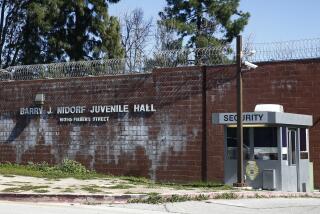$9-Million County Bailout Awaits Vote by Judges
In a big boost for the county’s troubled finances, administrators said Thursday that they have concluded difficult negotiations with Municipal Court judges about joining a new state program that should add at least $9 million to the county’s general fund.
The new bailout is significant, but if the government does not find at least another $12 million by Jan. 17, the county still will have to announce cutbacks and possibly layoffs to balance the budget, said John Sibley, associate county administrative officer.
“We’re very pleased we have an agreement,” Sibley said. “The money will definitely help out.”
The county’s general fund is about $23 million short of what it needs to operate at full strength through the remainder of the fiscal year, which ends June 30.
As for whether additional funds are likely to be found in the next 12 days, Sibley said Thursday, “All I can say is that I continue to express my optimism. . . . I don’t think there will be a doomsday report on the 17th.”
Thursday’s agreement, which includes a concurrence approved by the Superior Court judges last month, means that the county is expected next week to join a new program under which the state will assume much of the costs of operating the county’s courts.
The state’s Trial Court Funding Act--which was intended to bail out financially strapped counties throughout California--will generate about $12.5 million for the current fiscal year.
The dispute between county administrators and the judges was over how that money should be shared.
Sibley said the judges will get about $3.5 million from the program--which includes five new Superior Court judgeships--and the county will get at least $9 million for its general fund.
However, Central Presiding Municipal Court Judge Robert E. Thomas said late Thursday that he does not consider the agreement with the county to be final until it is voted on by all of the Municipal Court judges.
Vote Probable Next Week
Thomas said the terms of the negotiations were being put in writing and they probably would not be put to a vote until early next week.
“I hate to term it . . . an agreement,” he said. “I think it’s in the form of proposals . . . and until that vote is conducted, there is no agreement.”
But Thomas said he is “optimistic that the agreement will be completed, and completed on time.” The deadline for the county to join the state program is Jan. 15.
Last month, county officials said the $23-million shortfall could force the layoff of up to 1,200 employees--almost 10% of the county’s entire staff. That worst-case scenario would be averted with the court agreement.
But Sibley said he could not define exactly what the remaining unfunded balance represents in terms of jobs or programs. There are other funding sources that might still be used to generate the roughly $12 million still needed.
The county has $15 million in a contingency fund that is saved for unexpected costs such as lawsuits or for natural disasters. That should be enough to balance the budget for the remainder of the year, but it also is a key indicator for credit agencies in rating a government’s financial condition.
If the county’s credit rating was affected because it no longer had a contingency account, it would cost the government more to borrow money, meaning construction projects would be more expensive.
The county also is negotiating with the county employees’ Retirement Board, which has a fund surplus that it has been willing to use to help the government in return for meeting certain conditions.
Sibley said the latest proposal being negotiated with the Retirement Board would generate about $7 million for the current fiscal year, still leaving several million dollars that would have to come from the contingency account or a reduction in county programs.
More to Read
Sign up for Essential California
The most important California stories and recommendations in your inbox every morning.
You may occasionally receive promotional content from the Los Angeles Times.










